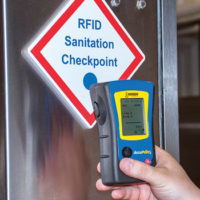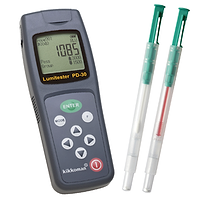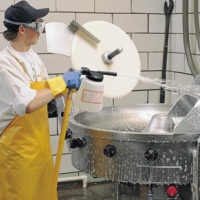For those too young to remember a time not dominated by radio frequency technology, it was a bleak world. You had to get up off the couch to change channels. You had to get out of your car and manually lift the garage door. Toll booths had nothing but hard-pass lanes. If you wanted to make a phone call a mile from your house, you needed a mile-long phone cord. The use of radio frequency technology has made so much of modern life easier.
A similar technological revolution using radio frequency identification (RFID) has occurred with adenosine triphosphate (ATP) sanitation monitoring systems designed for use in the food industry.
“We didn’t invent RFID technology,” says Neogen Corporation’s Rob Soule. “We simply took this terrific technology that’s been used in everything from inventory tracking to cattle identification to toll booth access and figured out a way to automate some of the things that our customers were telling us take up too much of their time.”
The latest technological advancements in sanitation monitoring have greatly simplified ATP test data plan creation, and test data collection and interpretation.
Using Automatic Randomization to Ease Daily Test Plan Creation
ATP sanitation monitoring programs are in place at close to 70 percent of food production facilities in North America. They are now very good at meeting the basic need to identify areas where cleaning was not effective.
“People are now looking at taking their programs to the next level,” says Soule. “The emphasis now is utilizing the data that are being collected to take a deeper look into what’s happening in the facility. And the basis for that is to have a strong, valid sampling program. The RFID system allows companies to collect their data on a random site selection basis AND to focus their efforts where they need to by identifying mandatory test sites.”
With the latest ATP sanitation monitoring systems, all a supervisor has to do is identify test sites just once as either being mandatory, meaning they are tested every day, or being of lower risk, which means the sites are among those that are tested on a random basis. With this information, a sampling plan can be automatically created on a daily basis—completely eliminating the supervisor’s once daily responsibility.
Using RFID Technology to Zip through Daily Testing
Using RFID technology for ATP sanitation monitoring typically involves two components: an antenna and RFID tags. The tags are passive, which means they give off no signal on their own. They simply reflect the RFID signal back to the instrument with their specific code, which is linked to the appropriate test site grouping. To keep from being a potential point of contamination, the RFID tags, which are about the size of a quarter, have been inserted into a 6-inch × 6-inch, brightly colored sign.
The user simply swipes the instrument near the tag and the site group is read automatically. From there, the instrument picks test sites within the site group automatically at random. And if the facility has chosen to designate some test sites as mandatory, meaning they’re “hot spots” or sites that need to be tested each time, those are presented first and appear in red on the instrument’s display.
“The RFID technology is the ‘wow’ factor of the newest ATP systems. We’ve tried to move the design of the day’s test plan from the manager’s computer to the instrument,” says Soule. “In the past, you would have to create a daily test plan on a computer and upload it to the instrument, then toggle and scroll, and toggle and scroll some more to get to the appropriate test site before you could test the site—for every site you tested. We’ve eliminated all that. With just one swipe, the instrument can be ready to test.”
Interpreting and Making the Best Use of Collected Test Data
Not only have the latest ATP sanitation monitoring systems greatly improved upon the creation of test plans and the actual testing, but the analyzing of the collected data has seen numerous advancements.
“We are in the information age and it’s really about how or what we do with the information that is important. Whether that information is used to comply with the seemingly endless global food safety regulatory initiatives, or simply finding a way to better produce your products,” says Soule. “The goal is to make sense of the data that are collected. Data collected through an ATP program are meaningless unless they can be interpreted and used to help modify sanitation programs to produce unerringly effective results—the ultimate goal of sanitation efforts.”
The newest ATP sanitation monitoring systems can easily produce single-page reports that detail:
• Results ranked by highest percentage of fails
• Results by test sites
• Results by test groups
• Results by date ranges
• Trends by monthly averages
For more information on the system, please visit www.neogen.com.
p>




